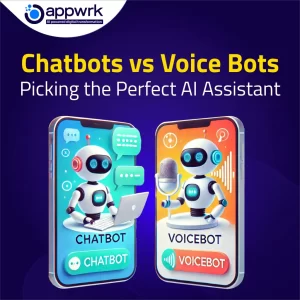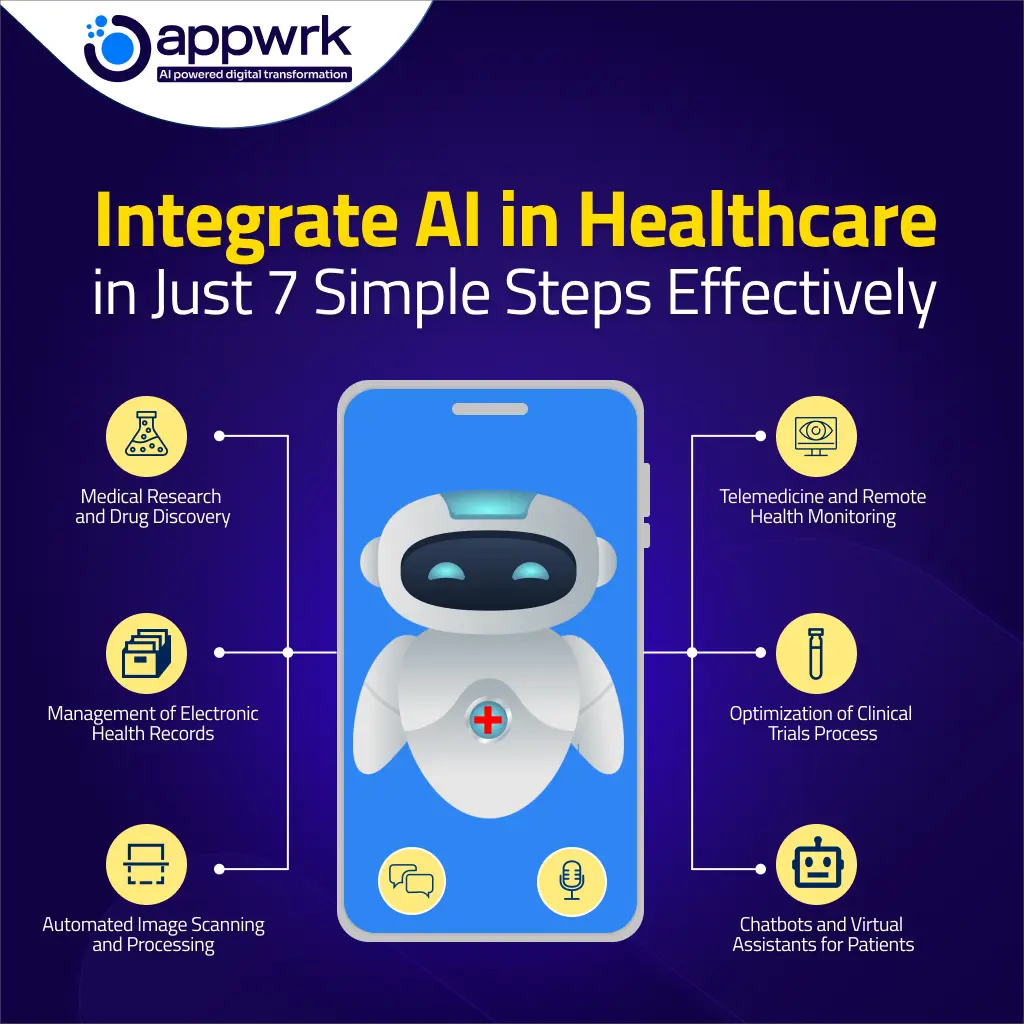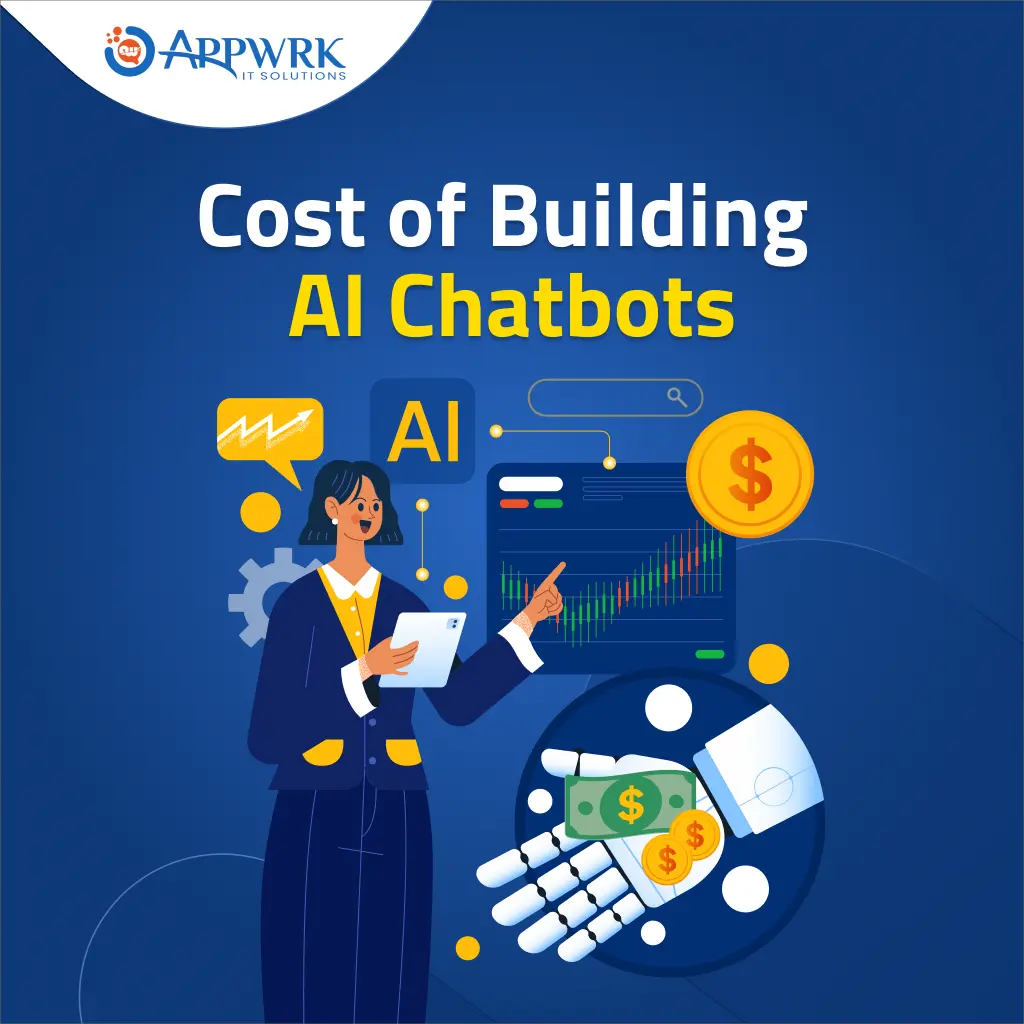Difference Between Chatbot and Voice Bot – Face Off 2025
AI in the 21st century has grown to become a true juggernaut of the current technological advancement. If you look back at the last ten years, you will witness that AI technology has been developed and widely implemented at a never-seen-before scale. So much so that around 75% of organizations look to implement AI-powered technologies by 2027. Isn’t that fantastic?
Digital businesses now employ AI tools such as voice bots and chatbots with the primary aim of bringing an all-new dimension to customer interaction. They are becoming the face of technology for visitors, and exactly resemble the ways humans converse. When you speak with them, it feels like you are talking to a live person, and the ease of experience it brings to the table is worth mentioning. By leveraging the power of machine learning and natural language processing, chatbots and voice bots are revolutionizing customer service dynamics in more ways than one.
We are more than happy to bring to your kind attention the fact that we have already integrated chatbots and voice bots into the websites of more than 94 business websites to date. This has led to better customer engagement, and thus improved conversion rates for businesses in the long run. However, against this backdrop, there arises a question, Chatbot vs voicebot: which is better? Well, that is exactly what we will be discussing here.
Today, we will take a look at how chatbots and voice bots differ from each other while zeroing in on their unique applications and benefits, thereby helping you make an informed decision and smart investment. So, let’s start.
Table of contents
- Chatbot vs Voice bot: Explanation
- Chatbot vs Voice Bot: How Do They Differ from Each Other?
- Chatbot Integration vs Voicebot Integration: What is The Difference?
- Chatbot vs VoiceBot: Which One Can Be A Good Fit for Your Business?
- Chatbot vs Voicebot: Which One to Choose?
- How Can APPWRK Help You Grow Your Business with AI Assistants?
Chatbot vs Voice bot: Explanation
Chatbots and voice bots have become the kingpin in the entire genre of AI-powered technologies, designed with the primary motive of improving the customer support process for businesses. With that in mind, let’s take a look at what actually they are, and what are the benefits that integrating each bring to the table.
A chatbot, also known as a chat robot, is actually a computer program created to engage in conversation with visitors, imitating natural language interactions as far as possible. Text-based interfaces such as websites, messaging apps, or dedicated chat platforms mainly use chatbots. They use natural language algorithms and pre-defined rules to comprehend and respond to visitor queries.
What are the benefits of Integrating a Chatbot?
Chatbots employ top-of-the-line technology to address customer queries. Harnessing such technology can bring a myriad of advantages to your business:
Perpetual Availability
Chatbots work tirelessly at your service, thereby ensuring instant assistance 24X7. Such limitless availability ensures visitors receive the information and support whenever they need it, irrespective of working hours or time zones.
Cost Efficiency
Chatbots are known to automate routine tasks and answer commission queries effortlessly. This significantly reduces the workload on human customer support agents. This credibility results in considerable cost savings for businesses, thereby allowing them to allocate resources more efficiently.
User Engagement
NLP-equipped chatbots can comprehend the nuances of human language. This technology allows for more appropriate responses and creates engaging and customized interactions, thereby improving the user experience.
What is a Voicebot?
A voice bot, also known as, a voice assistant is a specialized chatbot, that operates through voice interactions. It employs technologies like natural language understanding (NLU), automatic speech recognition (ASR), and speech synthesis, to understand spoken requests and provide verbal responses.
There is also another form of voice bot, known as a call bot, that can take care of phone calls in busy call centers. A call bot allows calls to be directed as per the requirements of the customers, categorizing and qualifying the request before forwarding it to the right department. Usually positioned as a voice server, it mainly functions as a call router. Not just that, it can also take care of answering the most common and simple questions instantly.
What are the Benefits of Integrating a Voicebot?
Voicebots are set to revolutionize the service industry. Some of the benefits that a business can reap from incorporating a voice bot into their website include:
Hands-Free Operation
Voice bots allow visitors to interact without manual input, thereby ensuring a convenient and seamless experience. This hands-free functionality comes in handy during situations when physical interaction is impractical, like when you are busy with other tasks like driving.
Multitasking
Since voice bots allow for interaction while using hands or having to divert visual attention, users can execute tasks while being occupied with other activities or on the move.
Accessibility
Voicebots offer an alternative mode of interaction for visitors with visual impairments and limited mobility. This contributes to inclusivity. It is the audible nature of voice interactions that widens their accessibility beyond conventional touch-based interfaces.

Chatbot vs Voice Bot: How Do They Differ from Each Other?
Both these conversational AI technologies differ in numerous key aspects. Here’s a tabular comparison of chatbot vs voicebot:
| Aspect | Chatbot | Voice Bot |
| Interaction Medium | Primarily text-based communication, with the help of written messages. | Employs Voice-based communication, processing spoken language. |
| User Engagement | A screen is essential for interaction, making it ideal for text platforms. | Allows for hands-free interaction, making it a good fit for scenarios like driving. |
| Use Cases | Well-suited for websites, apps, and messaging platforms. | It can be used on devices that do not feature a screen, like smart speakers. |
| Implementation | Can be easily integrated into apps and websites with text interfaces. | Requires specific hardware support and voice recognition technology. |
| Customization | Customizable through user-provided information and text inputs. | It packs the capability to recognize voice and may feature customized voice profiles. |
Chatbot Integration vs Voicebot Integration: What is The Difference?
Now, that you have a thorough idea of how a chatbot differs from a voice bot, we would like to point out that the integration process of both also varies to a great extent. Let’s take a look at the major points of chatbot vs voice bot integration difference:
| Basis of Comparison | Chatbot Integration | Voicebot Integration |
| Platforms | You will find chatbot integration mainly on websites, messaging apps, customer service portals, and social media platforms. | Voicebots are mainly integrated into IVR systems, IoT devices, cars, mobile apps, and smart speakers. |
| APIs | Chatbots employ RESTful APIs for webhooks and text communication. | Voice bots employ voice APIs like Alexa Skills Kit, Google Speech API, and webhooks. |
| Development Tools | Chatbots require bot frameworks like DialogFlow, Rasa, and Microsoft Bot Framework | Voice bots need voice development platforms like Google Actions and Alexa Skills Kit |
| Integration Complexity | Since chatbots involve text-based protocols and fixed frameworks, their integration complexity is relatively simple. | Since voice bots have to handle natural language nuances, voice recognition, and synthesis, their integration is much more complex. |
| Data Handling | Chatbots store, analyze and encrypt text data. | Voice bots store, process in real-time, and encrypt voice data. |
Chatbot vs VoiceBot: Which One Can Be A Good Fit for Your Business?
Selecting between chatbot vs voicebot is a decision that depends on several other factors like your business goals, the people you are trying to connect with, and the type of interactions you aspire to achieve. Here are some of the prime considerations:
User Preferences
- If your audience is comfortable with reading text-based messages and typing, chatbots can prove to be a great choice.
- They work supremely well on messaging apps and websites where visual information like written messages is extremely important.
- Voice bots are a good choice for those who may not be willing or able to use a touchscreen or keyboard and prefer hands-free, spoken interactions.
- Voice bots shine in situations where screen access or manual interaction is a daunting proposition, for example when user have their hands occupied or when driving.
Use Cases
- Chatbots are ideal for offering customer support on apps, websites, and messaging platforms.
- They are adept in responding to common customer questions, guiding visitors through various processes, and assisting with transactions with the help of text-based interfaces.
- Voice bots come in handy in situations where visitors must provide spoken commands and receive audible responses, like controlling smart home devices, playing music, and setting reminders.
- They are well-suited for environments and devices without screens, like car systems and smart speakers.
Context of Use
- Chatbots are good for environments where users are capable of and are comfortable with text-based input, like websites and messaging apps.
- They can be seamlessly integrated into platforms with text interfaces.
- Voice bots are good for scenarios where voice commands provide a more convenient and natural interaction.
- They are ideal for systems and devices with unavailable or impractical screen access.
Accessibility
- If your user prefers conventional text-based interfaces or is suffering from hearing impairments, things just can’t get better than chatbots.
- They require manual interaction and screen access, which might not be feasible in some contexts.
- Voice bots improve accessibility for users with visual impairments, limited mobility, and those who prefer hands-free interaction the most.
- They provide an alternative interaction mode beyond conventional touch-based interfaces, which in turn, promotes inclusivity.
Customization
- Customization in chatbots banks on information that a user provides through text inputs.
- You can custom-tailor the responses based on the data users provide in written form.
- Voice bots recognize human voices and offer a more customized experience on the basis of the unique vocal characteristics of each visitor.
Technology And Implementation
- Implementing chatbots is a relatively straightforward process, and involves incorporation into platforms with text interfaces.
- They utilize NLU technology to interpret and provide text-based responses
- Implementing voice bots calls for more advanced technologies, such as NLP to understand spoken language, ASR to convert spoken words into text, and speech synthesis to provide audible responses.
- Voice bots need specific hardware support for top-notch performance, particularly in dedicated voice-enabled devices.
User Engagement
- Chatbots engage visitors through text-based conversations, thereby making them a good fit for visually oriented platforms, where visitors can actively read and respond to messages.
- They can prove to be a great choice in situations where visitors are highly inclined to engage in written conversations and have sufficient time to do so as well.
- Voice bots facilitate hands-free interaction, thus improving engagement where visual attention is undesirable, such as exercising, cooking, and driving.
So, you see, speaking about chatbot vs voicebot integration, it primarily depends on your business goals. Also, there might be cases where you might have to integrate both chatbots and voice bots to meet the needs of a wider audience. The perfect choice would be the one that would align with your business goals, improve the user experience, and most importantly, cater to the varied requirements of your customers.
Chatbot vs Voicebot: Which One to Choose?
Well, truth be told, there is no direct answer to this question. Both chatbots and voice bots bring a dynamic of their own to the table. Both pack the potential to help you achieve your business goals. The best thing to do here is to find the perfect balance between your business requirements and consumer needs and preferences. To accomplish this, ask yourself some basic questions:
- What kind of user journey would I like to create?
- What kind of media do my users use?
- What are the various languages I should integrate into the bot?
- How much information do I need to propagate?
Finding it difficult to find the answer to these questions? Well, fret not. We, at APPWRK, are here to help.
How Can APPWRK Help You Grow Your Business with AI Assistants?
Bots, be it chatbots or voice bots, are the future of delivering exceptional customer service. Both bring a dynamic of their own to the table and depending on the specific needs of your business, you should select either one or both of them. If you are in the dark regarding what to choose, get in touch with our experts, here at APPWRK, and they will guide you on which one, chatbot vs voicebot, would be a good fit for your business. We will execute every step of integrating the bot into your website, right from scratch. This will not only save you from shelling out a fortune in the long run but will improve the user experience as well. This, in turn, will pave the way for improved operational efficiency and customer satisfaction in the long run.

FAQs for AI chatbot vs voicebots
Chatbot is typically an AI-powered software application that can conduct a conversation via text interactions. On the flip side, a chatbox is a chat interface that pops out, when you click the chat bubble or icon on a website. A chatbot’s primary function is to initiate a natural conversation with visitors. Businesses employ them to automate workflows and repetitive tasks and help sales, marketing, and customer support departments. Whereas, the chatbox serves as a means of communication between visitors and the chat application. It allows multiple visitors to make contact and collaborate in real time.
While IVRs provide pre-determined responses based on user inputs, voice bots take the IVR system a step ahead, employing conversational and generative AI to interpret and respond to user inputs.
A chatbot is a tool that packs the potential to simulate human conversation and interact with visitors through voice or text-based interfaces. On the other hand, conversational AI can be said to be a technology that enables machines to comprehend, interpret, and respond to natural language in a manner that imitates human conversation in the best way possible.
Yes, why not? You can integrate both chatbot and voice bot into your website, thereby leaving the users to choose between text and voice interactions based on their tastes and preferences.
They implement stringent security protocols, including secure data storage and encryption, to safeguard user information.
About The Author
























































